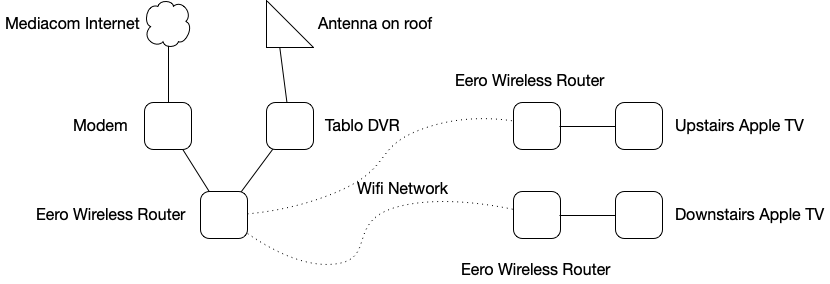Over the Air
March 19, 2020
I recently dropped our cable service and switched our home entertainment system to be centered around the Apple TV (the box, not the service), with an app installed to watch live news, sports, and other local channels. Here’s how I did it.
I used the otadtv.com tower locator to find that there were several over-the-air broadcast antennas within 30 miles of us. Since we live in Iowa and the terrain is almost entirely flat farmland, there’s very little to get in the way of a signal.
Equipment
- RCA Outdoor Yagi Satellite HD Antenna - link
- Tablo Dual Lite OTA DVR - link
- Seagate Portable 1TB External Hard Drive - link
- Apple TV HD - link
The RCA antenna is inexpensive, and mounted cleanly on the post on my roof recently vacated by the old Dish antenna we haven’t used in years. The one downside to the antenna is that the converter that screws into the antennas dipole was incredibly fragile, I accidentally snapped off both ends screwing them on by trying to screw them on too tight. Luckily the part is only $2-$4 at any local hardware store, so I bought two and kept one in a cabinet just in case.
The Tablo box is a DVR that hooks straight into the coax coming from the antenna. It then hooks into the local network either by ethernet, which I do, or over the wireless network. Since the box was going to be sitting right next to my modem and Eero router, it made sense to plug it straight in. The 1TB hard drive hooks into the Tablo box for DVR and commercial skipping capabilities. Finally, since I wanted the same experience upstairs that we have downstairs I bought a second Apple TV, but since the TV is so much smaller I opted for the slightly less expensive “HD” version instead of the “4k”. When and if we upgrade the upstairs TV to 4k, I’ll probably just buy another Apple TV box to go along with it.
Home Network
We upgraded our home cable service last year to a bundle of TV channels, home phone service, and internet. The only thing I was interested in the was the internet, but my wife enjoyed a few shows and liked having the cable, so we kept it. We needed two cable boxes, but only one of the boxes they delivered was a proper DVR, the other one would stream shows from it across the network. There was a ridiculous coax network setup when Mediacom installed the cable, but I changed it so each cable box hooked up over ethernet to an Eero router to communicate over the home network, and the boxes could download the tv guide from the web.
The new setup has each Apple TV plugged into ethernet into an Eero router, networked to the base Eero where the Tablo box is hooked up. I’ve got the Tablo app downloaded on the Apple TVs which gives me a single interface for movies, tv shows, and local news, weather and sports. As a bonus, I can now watch the morning news on my iMac or MacBook in Safari by visiting my.tablotv.com. We are still in the testing things out phase, but assuming everyone’s happy with the setup I’ll cancel my cable and drop back down to just internet service. With the reduction in price this setup should pay for itself in about four months.

